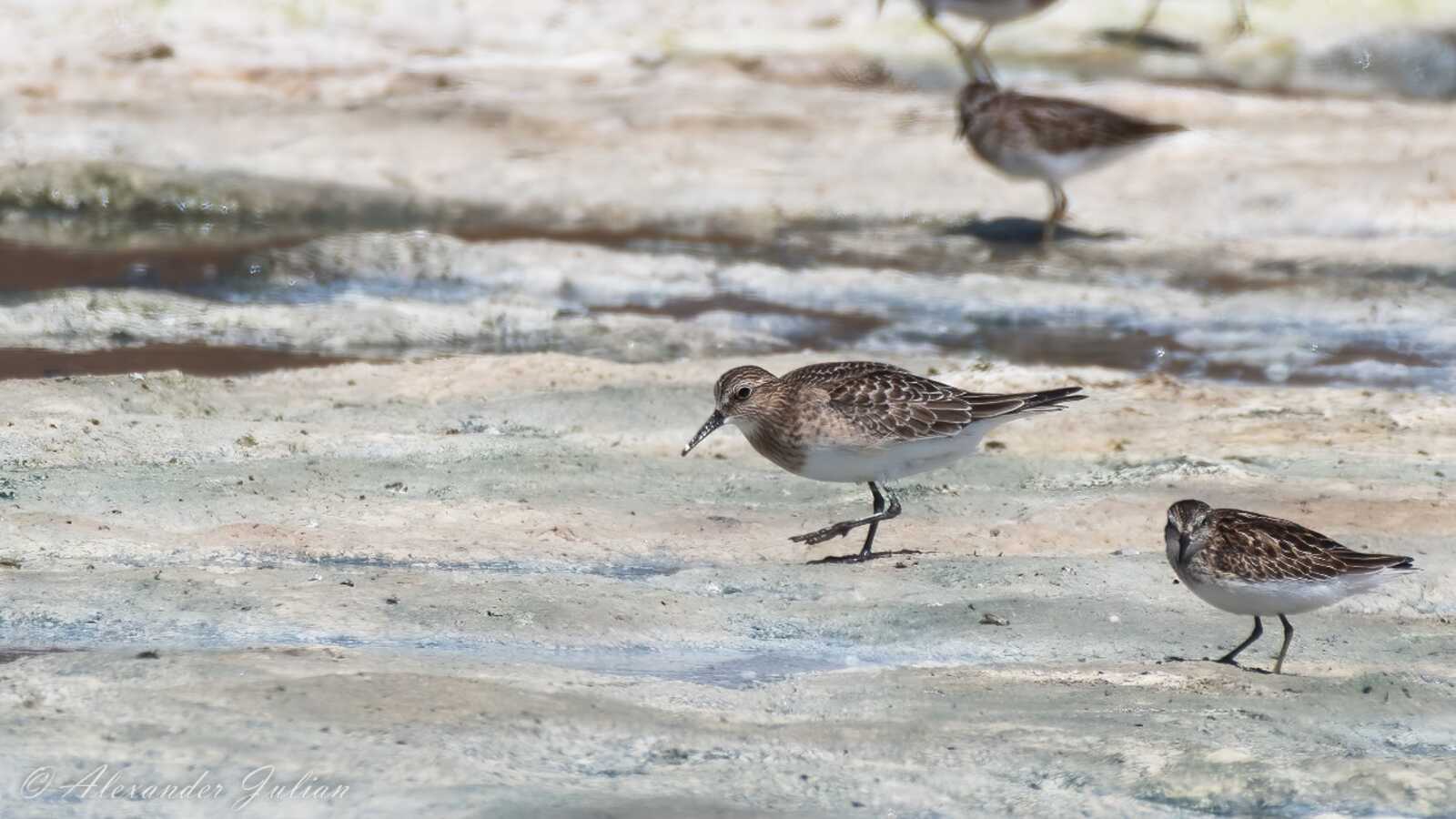
Quiz for Jan 2023
Quiz kindly prepared by Alex.
This photo was taken in Alameda County in Aug 2021. In the foreground we have two shorebirds to identify. We have pretty good views of these birds, but shorebirds can be tricky and leg color is not the only thing to look at as they can appear different when covered in mud. Good luck!
Answer will be displayed on February 1.
Answer:
Looking at this photo we can already exclude many types of birds, such as passerines, raptors, wading birds, gulls, seabirds, woodpeckers, waterfowl, rails, hummingbirds, kingfishers, swallows, and nighthawks.
This was taken in Alameda County, which is in the San Francisco Bay Area, in August. There are two shorebirds (birds that frequent shores of coastal or inland waters) on salt flats, often known as “peeps”. Peeps can often be hard to identify as they can look very similar, especially from a distance.
There are five peeps that we can see on the West Coast, and it is helpful to remember some distinguishing field marks. Leg color is a helpful identification tool, but it isn’t always reliable as the birds can get mud on their legs, which obscures their true color. Bill size is important to keep in mind, too: is it long, curved, straight, thick, or thin? Plumage color varies from dark browns to light grays and everything in between. Other markings, such as streaking on the breast, facial markings, wing length, and any unique markings seen while in flight, can be helpful in identification as well.
Least Sandpipers are the smallest of the group. They are small and short with a slightly curved bill, a streaked brown breast band, and they tend to have a light supercilium. Although they have yellow legs, they can appear lightish green or black when muddy. They are usually darker than other sandpipers, with a darker, browner color. They are often seen in a crouching posture. Winters and are common on the West Coast.
Semipalmated Sandpipers (palmated means webbed) are the next smallest with a short neck and small head. They have black legs, a straight bill, and are darker gray in non-breeding plumage with unstreaked gray sides. They have partially webbed toes, which are often difficult to see. They like to stay just at the edge of the water and are rare migrants to the west.
Western Sandpipers are larger than Least and Semipalmated but smaller than other peeps and look short and stocky with a large head and whitish face. They have a long drooping bill, very little streaking on the breast in winter, rusty brown highlights during breeding, and their wings (when folded) and tail are the same length. Winters on the west coast.
Baird’s Sandpipers are medium-sized, with buff brown plumage above and on the breast, whitish fringes on the upperparts, short dark legs, a gently drooping bill, and they are often seen in a horizontal posture. They have a long primary projection which extends beyond the tail and a dark rump in flight. They are uncommon on the West Coast.
White-rumped Sandpipers are medium-sized shorebirds with a literal white rump seen in flight. They look similar to Baird’s and have dark legs, but are grayer and have a very streaked face. When standing, the wings extend beyond the tail. They have a dark, medium-length bill, which is bicolored at the base: the top mandible is all dark, while the lower mandible is orange, fading into black. Very rare visitor to the West Coast.
Based on this information, we can immediately see that there is a touch of yellow on the leg of the bird on the right, and it is smaller and darker than the other bird in view. We can also see a short, thin bill, a brown, streaky chest, and it looks like the bird is crouching.
The bird on the right looks to be a Least Sandpiper, a common species on the West Coast.
The first thing that is obvious in the bird on the left is its larger size and posture. It is bigger than the Least Sandpiper, and it is in a horizontal position. It has black legs, a buffy brown color overall, a gently drooping bill, and wings that extend beyond the tail. These markings all point to a Baird’s Sandpiper. Mostly seen through the Great Plains on migration, an uncommon visitor to the West Coast.
Congratulations to Adrian, Pete, Jake, and Calvin for figuring out Baird’s Sandpiper (left) and Least Sandpiper (right).